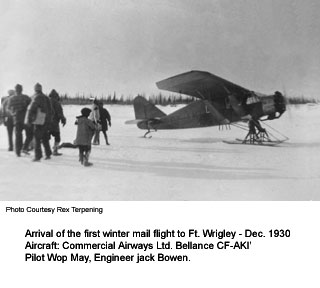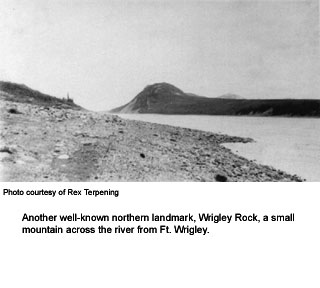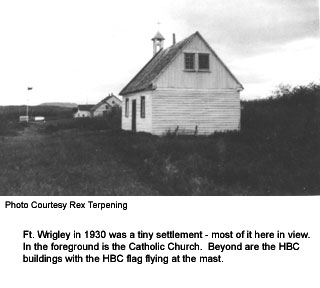Position: 63:13N-123:28W. Wrigley station was originally established in 1942 to service the US Army's Construction Battallion on the Canol Project. That project was abandoned in 1944 and the station was turned over to the RC Sigs in November of that year. It was closed in 1946 but reopened again as an RC Sigs staion in the spring of 1948 to provide weather information and to maintain the Canadian Pacific Airways landing strip. It was handed over to the Department of Transport on 3 May 1955.



A Brief History of Wrigley Station
(Excerpt from the Official History of the NWT&Y Radio System written in 1960)
December '41 saw the United States drawn into the war by the Japanese sneak attack on Pearl Harbour and by the Spring of '42 northwest Canada was to see many US Army personnel employed on the construction of the Alaska Highway from Edmonton to Whitehorse and Fairbanks, and the Canol Pipeline from Norman Wells to Whitehorse.
The NWT& Y Radio System became involved in supplying communications for both projects, especially for the Canol Pipeline….. The US Engineers undertook to improve the existing airports on the route so they could handle the aircraft being used and, in addition, to construct emergency landing fields at intermediate points such as Embarras, Alta., Hay River, NWT, Providence, NWT and Wrigley, NWT.
The US Signal Corps established small low powered high frequency stations at these points as well as at the main airports, including terminals at Edmonton and Canol (across the river from Norman Wells) to provide weather, air ground service and general communications for the project. However the net did not prove very satisfactory due to the low powered equipment and the vagaries of short wave with the result that a great percentage of the traffic was passed to the nearest RC Signals station and relayed over the NWT& Y Radio System. The NWT&Y Stations had higher powered shortwave equipment and also long wave equipment which was not subject to the 'blackout' like short wave. With this combination of equipment RC Signals were able to 'get through' at practically all times. This extra relay work placed an extremely heavy burden on the System stations, particularly at the main airports where there was a duplication of US Signals and RC Signals facilities.
By common agreement between the US and Canadian Governments, during the summer of 1943, it was decided that RC Signals, on account of their vast experience in northern communications and their already well established key stations, were much better qualified to handle all phases of communications for the Canol project.
Late in 1944 the American Government decided to abandon the Canol Pipeline Project presumably because the oil reserves available from friendly Allied sources now appeared adequate to supply the needs of Alaskan defence forces thus making a continuance of the pipeline from Imperial Oil at Norman Wells a costly and unwarranted expenditure. All American troops were withdrawn from the Mackenzie River area. By previous agreement RC Signals took over the operation of the US Signal Corps installations at the intermediate emergency airports of Wrigley, NWT Hay River, NWT and Embarras, Alta..
Lt. Bob Chinnick, TMO for the System, officially took over these stations in the order mentioned on the 17th, 22nd and 23rd of November 1944. At the same time the Department of Transport took over operation of the airports at these points.
Wrigley is situated on the west bank of the Mackenzie River halfway between Fort Simpson and Fort Norman. However, the Radio Station was located seven miles south of the settlement on the opposite side of the river where the airport had been constructed by the US Engineers. The original RC Signals staff consisted of ASgt. Ray Bird, Cp1. Edmond and Sigs Harding, Harward and Stager all of whom had been given a meteorological course prior to leaving Edmonton. The station therefore took its place immediately as a link in the System rendering a full complement of weather reports in addition to supplying communications for the area.
Operation and maintenance of the Wrigley airstrip was carried out by the Department of Transport until the Fall of '46 when it was decided that the aircraft activity in the lower Mackenzie River area had decreased to the point where such expenditure was no longer warranted. This decision of course also meant the closing down of the Radio Station, which was done on the 4th October 1946. Radio equipment was packed and shipped to Simpson and Hay River for storage while the personnel were posted to other stations.
The following summer (1947) the station was re opened by Sigs from June until late September to provide communications and weather information for a RCAF Photographic Survey Detachment.
Once again the Wrigley station was re opened in the Spring of '48, this time with Sigs personnel not only supplying communications and weather reports but also operating the airport including the maintenance of the strip.
Wrigley functioned on this basis until 1955 when RC Signals pulled out. The operation of the airstrip reverted to the Department of Transport once again. Canadian Pacific Airlines, practically the only user of the airport, assumed the task of providing communication facilities.
RC Signals Radio Station, Wrigley was turned over to the Department of Transport on the 3rd May 1955, thus terminating one of the most unique services rendered by any station of the NWT&Y Radio System during its existence.